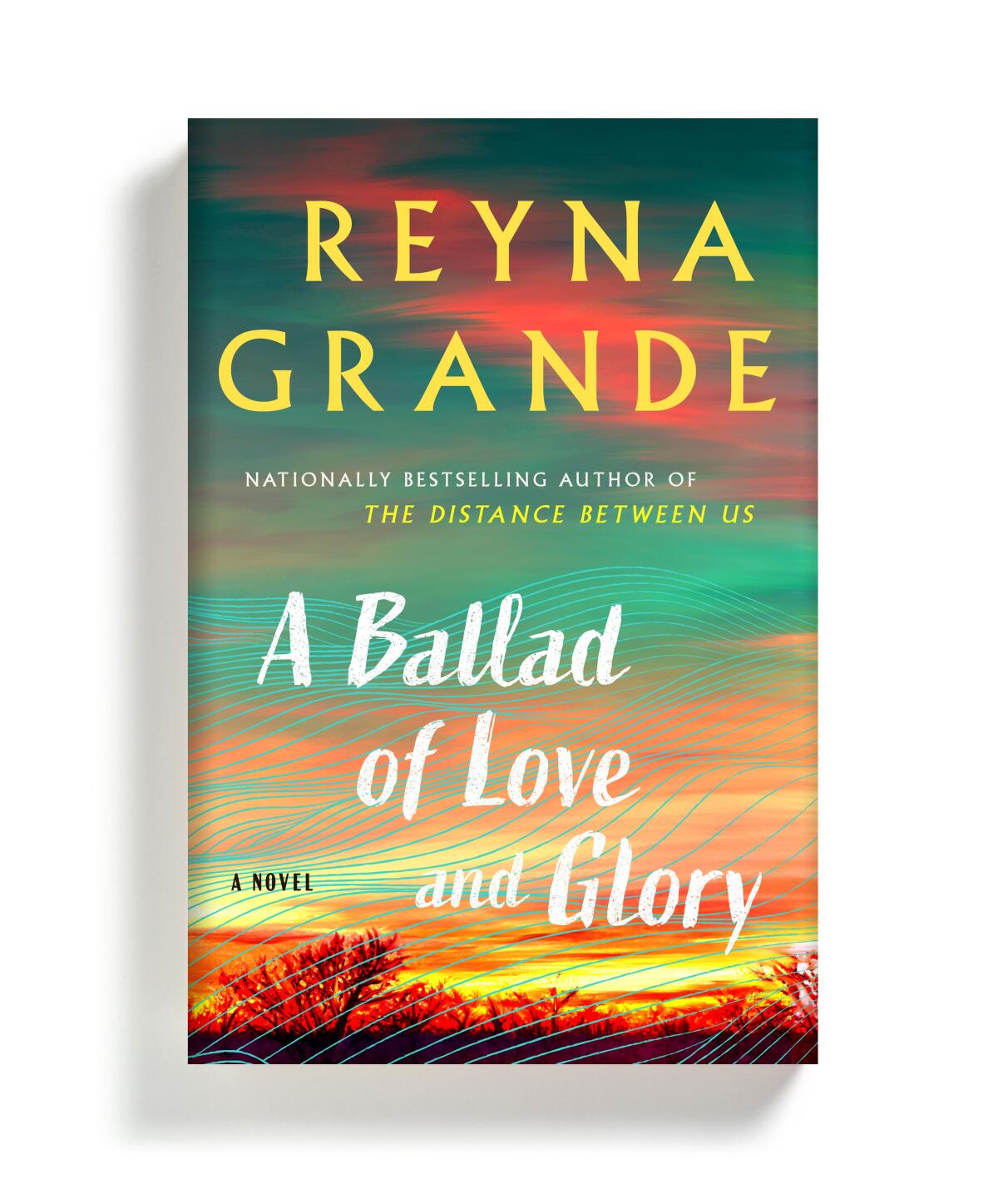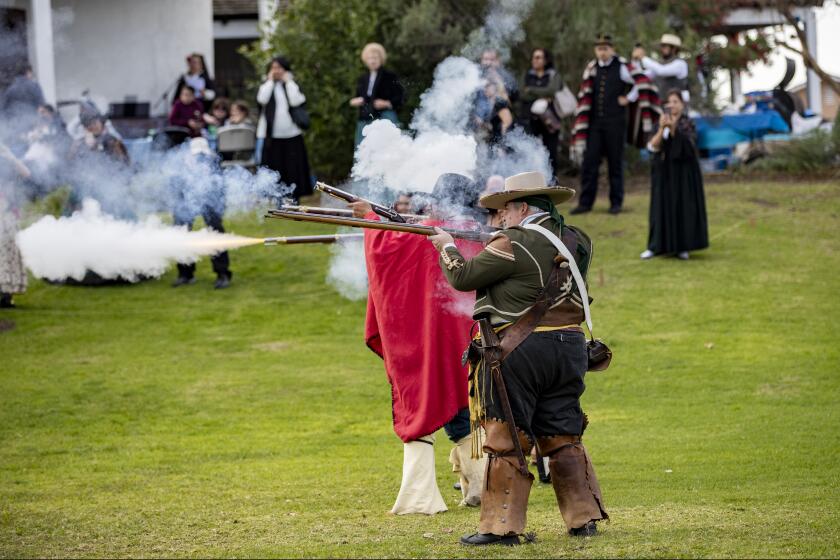Reyna Grande wants her new novel to help us rethink the term ‘invasion’

- Share via
“A Ballad of Love and Glory” is a novel Reyna Grande never planned to write.
After a reading in 2013, an audience member had approached Grande with a book idea: “Have you heard about the St. Patrick’s Battalion?”
Grande brushed it off. “Sometimes at events, people come up to me to talk and they tell me, ‘You should write a book about this, you should write a book about that,’” she said. “It often happens to writers, and this was the same thing.”
But the conversation piqued Grande’s curiosity. Back home, she turned to Google and learned that the battalion was a military unit of mostly Irish immigrants who enlisted in the U.S. Army, only to desert and fight with Mexico during the Mexican-American War. Their leader was named John Riley.
The more she learned, the more fascinated she became, and Grande says she spent seven years researching and writing the story. The bestselling author of “The Distance Between Us” and “A Dream Called Home,” Grande will join the Los Angeles Times Book Club on March 29 for a virtual conversation about her new novel, “A Ballad of Love and Glory.”

Set during the Mexican-American War, the book transports readers to 1846 as the U.S. Army marches south to the Rio Grande to wage war with Mexico. As the war escalates, a passionate relationship grows between Ximena, a talented Mexican curandera, and Riley, an Irish immigrant leading the battalion.
The foray into historical fiction, politics and war marks new creative territory for Grande, who has written extensively about her experiences as an immigrant. Born in Guerrero, Mexico, she was 9 when her family brought her across the border to California without a visa. Her first book, “Across a Hundred Mountains,” won an American Book Award in 2007.
In a recent video interview from a Sacramento cafe, Grande spoke about U.S-Mexico relations, what she learned researching the novel and what she hopes readers take away from her story.
Take me back to that day as an undergraduate student at UC Santa Cruz when you first learned about the Mexican-American War in class. How did you feel?
Learning about it was surprising, because society had been telling me I wasn’t supposed to be here as a Mexican immigrant, as a Spanish speaker. When I found out that California had once been a part of Mexico and that Spanish was spoken here before English, it startled me because I realized that maybe I wasn’t the outsider.
The Mexican-American War of remade the U.S. and Mexico — and the much-debated border that separates the two countries. But it remains a relatively overshadowed conflict in American history. In Montebello, a group of men and women try to educate people by reenacting a key battle.
How did that history reshape your understanding of Mexico and the U.S.?
I learned about the U.S. as an invader, which is not the story we tell of this country. It’s something to think about right now with Russia’s invasion of Ukraine. We’re staying away from talking about how the U.S. has been an invader, beginning with the Mexican-American War — that was the first time the U.S. invaded a foreign country. But we don’t learn about this in school. It doesn’t fit into the narrative and the national mythology we’ve created about this country.
What has it been like following Russia’s invasion of Ukraine after writing about a similarly violent moment in history?
I’m seeing the injustice of an invasion carried out by a powerful country against a weaker nation. It’s the same thing that happened with the U.S. They tried to justify this war based on lies and half truths, so I’m seeing a parallel to that. Also, the photos that we’re seeing of the cities in Ukraine, the devastation, the violence, the dead and the wounded — I think about that too with the U.S. invasion of Mexico. That’s why it was important to me to not shy away from violence in the book. You see a lot of very vivid battle scenes, all the blood and all the gore.
If I was going to write about the war and the invasion, I wanted to immerse the reader in that moment — to have them see what that looks and feels like.
Did writing those scenes take a toll?
It was emotionally difficult because I felt that I was there with my characters. I wrote a lot of these scenes during the pandemic, and it helped me because the uncertainty that COVID-19 created in all of us — the anxiety, the depression, the stress — I channeled all of those emotions into the writing. My characters were experiencing their world being upended in a similar way. I was worried, I had a lot of fear about the future, and I put all of those things into the novel. That was my form of therapy.
Grande explores “the war that the U.S. cannot remember and Mexico cannot forget.”
What was it like switching back and forth between fact and fiction?
I really wanted it to be historically accurate. I didn’t want to take too many liberties with the story and risk having the reader question its authenticity. So I tried to stay true to the timeline, the way the events unfolded.
You could Google anything I write in the book and you’ll see that it’s true. The war took place over two years, so that was my timeline, starting in March 1846 and until right after the Treaty of Guadalupe Hidalgo was ratified in 1848.
You’ll notice that the last chapter does not have a date on it; that was the only time when I did use creative license because nobody knows what happened to John Riley after he was released from prison. There’s a few military records of him still being in the Mexican army until he was discharged, but after that he disappeared from the records. So I left that last chapter undated, because I wanted to point out that that was not part of the historical timeline. That was me imagining how his story ends.
In your opening letter to readers, you mention that not much is known about Riley’s personal life because parish records were destroyed in a fire, and all you knew about Ximena — a widowed healer and Riley’s eventual love interest — came from John Greenleaf Whittier’s “The Angels of Buena Vista.” How did you bring them to life?
With Riley, I knew stuff about him. I knew he had come from Ireland, that he had been in the British army before that, that he had a son. I knew when he enlisted in the U.S. Army, when he deserted, what battles he had participated in, what happened to him when he and the other San Patricios got caught.
The challenge for me then was to get inside his head, to understand his motivations and explore his wound, because what haunts him is that he had joined the British army and had been a traitor to his people [in Ireland]. In my interpretation of Riley, I think that’s why he joined the Mexican army, to redeem himself.
I also gave him my own experiences as an immigrant. I know first hand what it’s like to not be wanted by U.S. society, to feel the discrimination and the micro aggressions. I gave him that inner turmoil of wanting to belong in this society, to be accepted, to be loyal to this country and to try to prove that he deserves to be here, all while the discrimination, the abuse, the insults start to get to him, until he realizes that no, there’s something for him here.
I fell in love with John Riley (laughs). A friend read the manuscript and said, “John Riley is too perfect, he needs flaws,” and I responded: “Can his flaw be that he’s perfect?”
“Of Women and Salt,” tracking generations of Latinas, comes out of Gabriela Garcia’s family story, life experience and advocacy for migrants.
What of yourself did you give to Ximena?
I gave her my love of nature. I’m a gardener, and Ximena observes and really appreciates the gifts that Mother Nature gives us. I also gave her my grandmother. My Abuelita Chinta inspired the character of Nana Hortencia. My grandmother died a long time ago, but when I was writing those scenes with Nana Hortencia, I really felt that I could hear my grandma talk to me. I miss her. That’s one of the things I lost when I immigrated to the United States — my relationship with my grandma. Whenever I wrote those scenes between Ximena and her grandma, I imagine this is the kind of relationship I would’ve had if I hadn’t immigrated.
What research did you do to write the dialogue between the Irish soldiers?
I wanted them to sound real, especially the way they talked in the 1840s. I read books about Irish peasants in the 1840s and developed an ear for the way they speak, the diction, for Irish sayings, and then I made a list of words that they used. I wanted to have an Irish reader check my work, so I emailed the head of the history department at a university in Galway and told them I was looking for somebody to help me with my novel.
He put me in touch with one of his former students who is now a historian. He read the manuscript twice, and he was very impressed with my Irish dialect. He corrected a few things and helped me add some Irish Gaelic.
I paid so much attention to John Riley but not so much to Ximena. After reading the manuscript, a friend said, “Your Irishmen sound more Irish than your Mexicans sound Mexican.” So I went back and added a bit more Spanish and words that are both in English and Spanish.
What do you hope readers take away from the novel?
For my Mexican and Mexican American readers, I hope they feel empowered, because it’s reclaiming our history and offering a new perspective and a corrective. For other readers, I hope it helps them understand why U.S.-Mexico relations are so complex and gives them a different understanding of the southern border.
And I hope it helps them rethink the word “invasion” that anti-immigrant people use to talk about immigrants coming to this country. Because who is the invader? Who invaded whom?
Book Club: If You Go
What: Reyna Grande discusses “A Ballad of Love and Glory” with Times editor Steve Padilla at the L.A. Times Book Club.
When: 6 p.m. March 29.
Where: Free virtual event will livestream on Twitter, Facebook and YouTube. Get tickets and signed books on Eventbrite.
Book club newsletter: Join our community book club: latimes.com/bookclub
More to Read
Sign up for our Book Club newsletter
Get the latest news, events and more from the Los Angeles Times Book Club, and help us get L.A. reading and talking.
You may occasionally receive promotional content from the Los Angeles Times.











